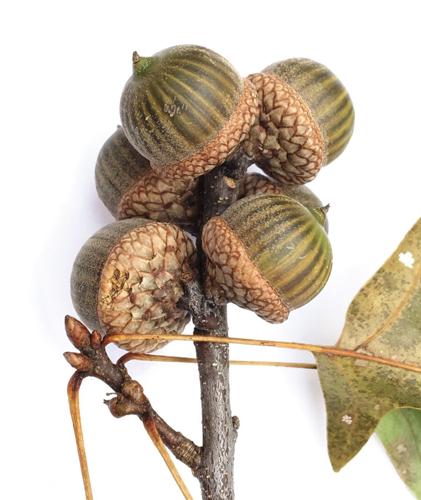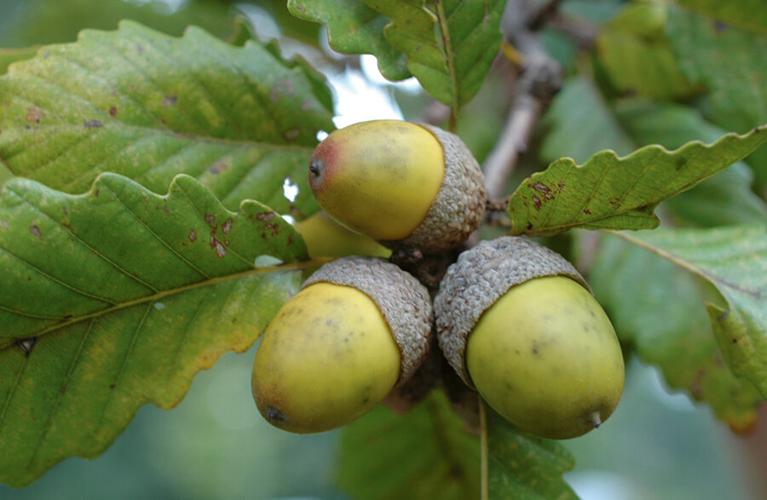
Pin oak acorns take two years to mature. (Ron Burkert/CC BY 4.0)
Great oaks may grow from small acorns, but only from acorns that have overcome great odds. According to the University of California, only one acorn in 10,000 survives to be an oak tree. Here are more facts.
It’s alive! Inside each acorn is a living and growing embryo of an oak tree.
Seed feed: To nourish that baby tree, an acorn contains high amounts of protein, carbohydrates and fats, plus calcium, phosphorus, potassium and niacin.
Kidney killer: As a deterrent to those who would eat it, an acorn contains tannin, a toxic polyphenol that interferes with many animals’ ability to metabolize protein, which in some cases can cause kidney damage and even death.
Hard nut to crack: To get at the fatty protein in an acorn while reducing the risk from tannins, some animals have devised work-arounds. Some choose acorns that contain fewer tannins, such as white oak. Others “cure” them. When jays and squirrels bury acorns, it’s not just for winter fodder; they don’t eat them until groundwater has had enough time to leach out the tannins. Other animals can consume tannins with fewer harmful effects.
Mast-ive! Every four to 10 years, an oak tree produces five to 10 times its normal annual acorn yield. During this “mast” year, one mature oak may produce 1,000 pounds of acorns. This crop exceeds what animals can eat, ensuring that some of the acorns will have a chance to become trees.

Chestnut oak acorns mature in one year. (Bruce Kirchoff/CC BY 2.0)
Seed the future: Druids consumed acorns, which were thought to have prophetic qualities. “Druid” is derived from the Celtic word for acorn.
Nuts about acorns? You should do oakie-dokie on this quiz
Because the Norse god of thunder, Thor, was said to have once taken refuge under an oak tree, believers thought that putting an acorn on a windowsill would prevent lightning strikes. My question is, what do I put on my windowsill to prevent the loud thunder of acorns raining down on my roof every fall? I confess that I thought all acorns looked alike until I wrote this quiz. Answers are below.
- Blackjack oak (Quercus marilandica)
- Chestnut oak (Quercus montana)
- Northern red oak (Quercus rubra)
- Pin oak (Quercus palustris)
- White oak (Quercus alba)
A. This 1.25–1.5 inch acorn is one of the largest in native North American oaks, although not as large as that of the bur oak. Its thin, bowl-shaped cap, or cupule, covers about half of the nut and is downy and light brown on the inside with a rough, reddish-brown exterior. When ripe, the oval nut is a shiny, chestnut brown.

The oblong white oak acorn takes one year to mature. (Steve Hurst/USDA-NRCS PLANTS Database)
B. This acorn’s oblong nut, when ripe, is glossy greenish-brown and 0.75–1 inch long with a pointed tip at its uncovered end. Its woody, knobby cap covers about a fourth of the nut. Tannin, a chemical that makes acorns bitter and their proteins harder to digest, is less concentrated in this acorn, making it desirable for many animals.
C. This plump, medium-brown, barrel-shaped acorn is 0.75–1 inch long. Its flat cap consists of closely pressed scales and covers about a fourth of the nut.
D. This acorn’s thin, light brown cap covers less than a third of its 0.375–0.5 inch globelike nut. The green-striped nut turns pale brown as it matures.
E. The scales of this acorn’s reddish-brown, turban-shaped cap have short downy hairs that are often found on its inner surface. It covers one– to two-thirds of the 0.5–0.75 inch, faintly striped, elliptical nut that ends with a stout, pointed tip.
ANSWERS
A. Chestnut oak
B. White oak
C. Northern red oak
D. Pin oak
E. Blackjack oak



(0) comments
Welcome to the discussion.
Log In
We aim to provide a forum for fair and open dialogue.
Please use language that is accurate and respectful.
Comments may not include:
* Insults, verbal attacks or degrading statements
* Explicit or vulgar language
* Information that violates a person's right to privacy
* Advertising or solicitations
* Misrepresentation of your identity or affiliation
* Incorrect, fraudulent or misleading content
* Spam or comments that do not pertain to the posted article
We reserve the right to edit or decline comments that do follow these guidelines.